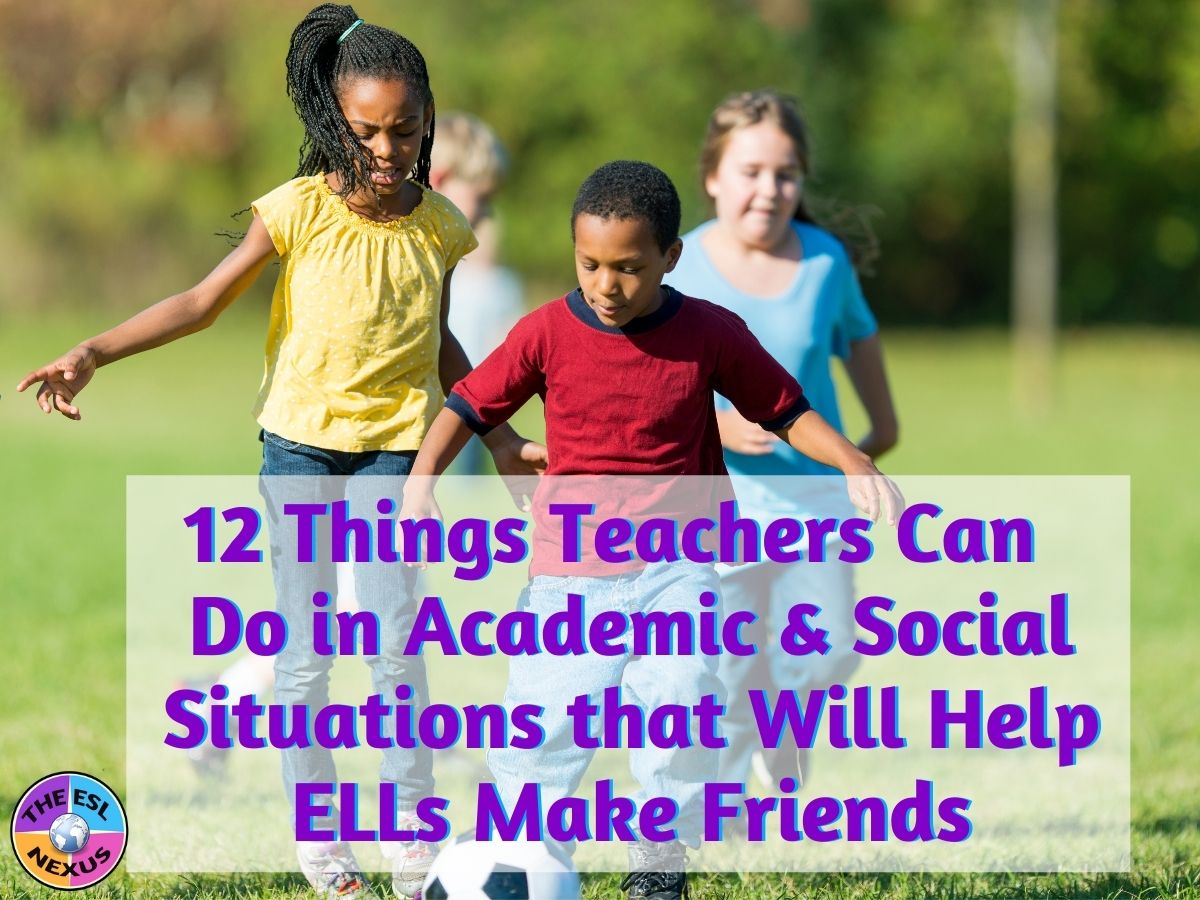Making friends isn’t easy. I know – I attended a different high school every year for 10th, 11th, and 12 grade. Making friends is even harder when you’re trying to communicate in a foreign language. I know – I was an exchange student to Sweden my senior year and went to a Swedish-language high school, and had to learn the language from scratch.
So I totally understand how hard it can be for English Language Learners who are new to a school and/or do not know a lot of English. What can teachers and other school staff do to make the adjustment easier and help the ELLs make friends? Let’s look at some challenges that make it difficult for ELLs to make friends and then at some solutions to them. But please note that the ideas I’m going to present are focused on when you’re teaching in-person classes at school, not when you’re teaching remotely.
 |
| Source: The ESL Nexus |
CHALLENGES
a) Perhaps the biggest challenge is when ELLs are in pull-out ESL classes during the school day. That reduces the chances ELLs have to mix with their peers because an ESL class will, by definition, be comprised only of students for whom English is not their first language. That can make it harder to get to know native English-speaking students, especially if ELLs are nervous about speaking English, which many are.
b) Another challenge is that it’s hard to talk when you don’t have the vocabulary to communicate easily. A lot of native English-speaking kids don’t know what’s involved in learning another language and may not have the patience needed to get to know English Language Learners. But recess and other non-academic times at school are excellent ways to get students to mix together.
c) The last challenge I want to mention is that of time. ELLs typically need more time when interacting with people because they are often processing what they hear in English and translating it into their native language. Or they are searching for the English words to convey their thoughts. However, during the school day, time is at a premium.
 |
| Source: The ESL Nexus |
SOLUTIONS
a) Usually when ELLs are in pull-out classes, they do not spend their entire day in ESL classes. At the very least, they have gym, music, art, and other “specials” with native English-speaking students. There are a few things regular ed teachers can do to foster friendships among the ELLs and the other students in a class:
* Seat an ELL and a native English speaker next to each other so when there is pair work to do, they can work together. (Of course, during the pandemic, they can’t be too close.)
* When doing group work, assign the members of the groups to ensure there’s an ELL in every group. If students are allowed to pick who their group will be, they might not select an ELL, but working in a small group is a great way to get students talking to each other.
* When assigning homework assignments, have students in pairs or small groups comprised of a mix of ELLs and other students explain the work to each other to ensure they understand the task. That not only will get kids talking to each other, it’ll also help you see if everyone knows what they are supposed to do.
* If you are given advance notice that an ELL will be arriving in your class, let your students know and ask them to be extra friendly. They can do that by, for example: Making sure to say hello to the new student and introducing themselves, walking next to the ELL in the hallway when going to and from classes, offering to show the ELL where the bathroom is, how to use a locker (if that is a new thing), explaining what intercom announcements mean, and so on.
* When you learn that you’ll be getting an ELL in your class, inform your students and let them know what country the student is from (if they’re an immigrant or refugee) or what their native language is (if they were born in the US but speak another language at home). Generate a list of questions about the country that your students can ask the new ELL, but emphasize that they shouldn’t bombard the ELL all at once. Also let your students know that the ELL’s level of English proficiency may make it hard for them to understand what’s going on all the time, so they should be patient and know that they may need to repeat themselves sometimes. Make sure your students know that the ELL is just as smart as they are but just needs some extra help in learning how to show that in English.
b) Even when ELLs do not have a large English vocabulary, there are still ways they can communicate. Lunch and recess are great opportunities for kids to practice social language. Mix It Up Day, sponsored by Learning for Justice, is a great way to help not just ELLs but all students get to know new people. Here are a few things adults on lunch and recess duty can do to create opportunities for ELLs and other students to interact with each other:
* At lunchtime, arrange for a few students to sit and eat with the ELL. They may even need to show the ELL how to go through the lunchline, if there is one. If the native English speakers don’t know what to talk about it, here are a few suggestions: Ask the ELL what their favorite subject is, ask the ELL what they like to do for fun after school, ask the ELL if they have a favorite singer or movie. It’s probably not a good idea to ask the ELL about their family in case they are coming from a traumatic situation. If the ELL brings lunch from home, the other students could possibly ask about the food but only if done in a positive way that celebrates the food rather than denigrates it.
* Organize structured activities for the students instead of letting them just do whatever they want and hang out with whomever they want. There could be a different activity each day or on just a few days, or an activity could last for just part of recess time, depending on the length of recess. You could have either all students participate or just some take part, depending on the activity. But including the ELLs in these activities, and creating times when the other students have to explain the activity or talk to the ELL in order to do it, can help the ELLs feel more comfortable with their fellow students.
* You could also ask a small group of students to invite the ELL to join them. If you do this, it’s best to talk to the native English speakers first about it. They should know that they will probably need to speak a little more slowly than usual and wait a little longer for a response when talking with the ELL since it may take them longer to understand what they’re saying.
* If you’re on recess duty and you see an ELL by themself, ask them if everything is okay. They may be fine but they may also be shy and not feel comfortable approaching the other kids. You can probably sense if that’s the case. If it is, find a student that you know is friendly and kind and ask them to help you out by playing with the ELL; you can give them ideas for simple activities to do together. Introduce the students to each other and tell the ELL that this other student has a game (or whatever) they’d like the ELL to do with them.
c) Take advantage of any interludes you may find in the day’s schedule. Before and after school, as well as homeroom, are good examples.
* If feasible, set up a before-school program that helps kids with their homework. Focus on the ELLs but also allow other students to participate. Such a program helps the ELLs with their schoolwork and, with the inclusion of native English-speakers, helps foster interaction between students. My blog post about the program I set up will give you some ideas about how to implement this.
* During homeroom in the morning, you can design quick and easy speaking activities for your class. For example, put a question on a whiteboard or send it to students’ devices, and tell them to discuss it with a classmate. You can structure it more by specifying that students have to talk to someone they don’t know very well or haven’t talked to yet that day, to increase the chance of different students talking to the ELL each day.
* If it is practical, you can also try to implement an after-school program that is open to all students. It could be a homework help program or some sort of social activity. Encourage the ELLs to participate by sending home information to their families. However, an after-school program only makes sense if transportation home is provided for the students.
It can take a long time to make friends if no one makes an effort to help ELLs do that. Eventually I made some friends in each of the schools I attended but if my teachers had done any of the suggestions recommended above, I probably would’ve made friends more quickly. I hope these suggestions help your ELLs make friends in their schools!




